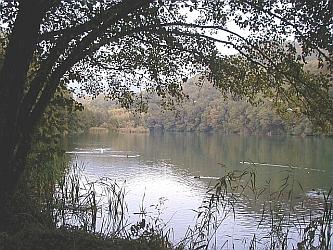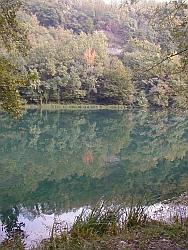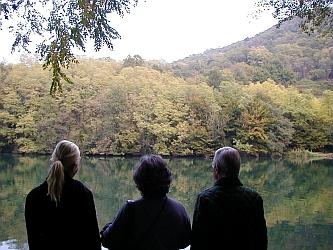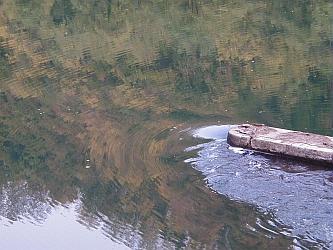Alternative Hydraulics - John Fenton Homepage




Why Alternative Hydraulics?
The practice of research in hydraulics seems to be very conservative. What is already accepted will be accepted, while any original thought is under-valued. A rather more sophisticated view of this, of course, is resistance to paradigm change described by Thomas Kuhn (see, for example, Scientific Method).
I have had a lot of difficulty getting research accepted by reviewers and editors. This is an attempt to develop a site where my own ideas might be developed - and criticised by others, in the form of E-mail to JohnDFenton@gmail.com. It is to be hoped that the anarchistic spirit of a really free market will prevail in the long run.
The view that the peer-review process is broken is shared by others:
Tipler (2003) on refereed journals
Victory and vexation in science: Einstein, Bohr, Heisenberg, and others by Gerald James Holton
Collected papers in applied mathematics, coastal & ocean engineering, and open channel hydraulics
This is a list of the papers with active links: List of Papers
Recent research results and writings in hydraulics
Basic physical processes in rivers
Fenton, J. D. (2015) Basic physical processes in rivers, Chapter 1 in Rivers – Physical, Fluvial and Environmental Processes, (eds) Pawel Rowinski and Artur Radecki-Pawlik, Springer.
Abstract: A "one-and-a-half"-dimensional model of a river is developed. It is actually one-dimensional but allows for horizontal curvature using natural curvilinear co-ordinates. The governing long wave equations can be developed with very few limiting approximations, especially using momentum rather than energy. The curvature is then shown to be rarely important and is subsequently ignored. Wave periods, imposed by boundary conditions, are asserted to be fundamental. Long waves have speeds and propagation properties that depend on period, and there is no such thing as a single long wave speed. Examination of dimensionless equations and solution of linearised equations using wave period shows a novel interpretation of terms in the momentum equation: the "kinematic" approximation and wave are misnomers: the approximation lies not in the neglect of inertial terms but is actually a very long period one. The outstanding problem of river modelling, however, is that of resistance to the flow. A large data set from stream-gaugings is considered and it is shown that the state of the bed, namely the arrangement of bed grains by previous flows, is more important than actual grain size. A formula for resistance is proposed which contains a parameter representing bed state. As that state is usually changing with flow, one can not be sure what the resistance actually will be. This uncertainty may have important implications for modelling. The momentum principle is then applied also to obstacles such as bridge piers, and a simple approximation gives greater understanding and a practical method for incorporation in river models. Finally, river junctions are considered, and the momentum approach with the very long period approximation shows that they can be modelled simply.
Long waves in open channels - their nature, equations, approximations, and numerical simulation
This is a paper I presented to the 19th Congress of the Asia-Pacific Division of the IAHR in September 2014, Ha Noi, Viet Nam.
Several results are obtained that contradict current understanding and practice:
- Some generalisations of traditional terms in the long wave equations are described, including a simple approximation for non-prismatic channels.
- Criticism is made of traditional reliance on the Gauckler-Manning equation. It is suggested that the Chézy-Weisbach formulation is much to be preferred
- The method of characteristics is also criticised for providing misleading insight into the nature of the equations and the waves they describe.
- It is shown that long waves have propagation characteristics that depend on wave period, so that the behaviour is much more complicated than believed using results from the method of characteristics.
- Traditional methods of non-dimensionalising the equations also give a misleading picture of them. Terms that have been previously believed to be inertial terms, of the magnitude of the Froude number squared, are in fact of the magnitude of the time rate of change of boundary conditions such as the inflow hydrograph.
- Accordingly, it is asserted that the kinematic wave approximation is not that - it is in fact a very long wave approximation. Correspondingly, there are no such things as kinematic waves, just very long waves.
- Considering computational methods, the simplest forward-time central-space finite difference scheme is shown not to be unconditionally unstable as is widely believed. It can be used to develop simple numerical methods.
- Finally, the problem of an open downstream boundary is considered and a good treatment is shown to be to simply treat the end point as if it were an ordinary point in the stream (which it is!) and numerically solve the equations there also. This is in opposition to current theoretical understanding, but it seems to work well.
New - The long wave equations for arbitrary slopes
Recently while working with Elham Darvishi from the University of Tehran on a Boussinesq equation for simulating flows with finite curvature, we discovered something that we had not known. V.T. Chow in his "Open-Channel Hydraulics" (1959, §2-10) and F.M. Henderson (1966, eqn 2-2) both knew it for uniform flow 50 years ago. Maybe everybody else knows it, except for me but I thought I would mention it here, just in case. It is this: in an open channel with resistance, the pressure distribution is not hydrostatic. The pressure head is, in fact, for gradually varying flow, h/(1+(d\eta /dx)²), where h is the depth of fluid above a point (the hydrostatic value), and d\eta/dx is the free surface slope.
Of course, this effect of slope is negligible for almost all rivers and canals, and the hydrostatic approximation is usually accurate. For some applications, and certainly for spillways, chutes, ramps, and some flumes the slope effect may be important. Even if it is not, the general statement that in a flowing channel, the pressure is not hydrostatic is interesting at least. As the resistance leading to the pressure being modified actually comes from the flow, the terminology "hydro-static" is no longer available to us. It might be termed the "local uniform flow approximation", corresponding to a uniform flow with the slope of the free surface.
With this in mind, I re-worked long wave theory to include the effects of slope on pressure in the fluid, and also its effects on the resistance term. The resulting theory for finite slopes can be found at The long wave equations for arbitrary slopes, while a traditional long wave theory for small slopes can be found at The long wave equations. The two documents are substantially similar except where the generalisations are made. The new one also contains generalised Chézy - Gauckler - Weisbach - Manning - Strickler formulae for steady uniform flow on finite slopes. The only modification is that in the traditional formulae for velocity, there is a factor of 1/(1+S²) to include, where S is bed slope.
The result has some implications for the modelling of flow over broad-crested weirs and spillways. Whereas ideal fluid theory with no resistance works well in the crest region where slopes are small, further downstream it does not because it fails to model the pressure and resistance contributions, the only important ones. And, of course, using it the fluid accelerates off to infinity. It cannot describe uniform flow.
The long wave equations
It is surprising that derivations and presentations of the long wave equations have usually stopped short of presenting them in useable form. In this paper the long wave equations for a straight channel are derived using the integral mass and momentum conservation equations. The derivation contains certain innovations. It attempts to be a true hydraulic one, where quantities are modelled as simply as possible. Results are in the form of equations which are of immediate applicability and in which the physical significance of terms is clear.
The long wave equations for a channel curved in plan
The traditional fiction in hydraulics is that All Rivers Are Straight. They are not. This corrects the long wave equations, to allow for channel curvature in the horizontal plane, as exhibited by most rivers!
In 1995 at the IAHR Congress in London, I presented a paper with Guinevere Nalder, a student of mine, on this topic: Long wave equations for waterways curved in plan. It was later expanded considerably and submitted to the Journal of Hydraulic Research, where it was rejected. One referee observed that we had not allowed for the separation of flow around bends. He presumably believed that the usual straight-channel approximation does allow for that. This is the theory based on that paper.
Calculating resistance to flow in open channels
The Darcy-Weisbach formulation of flow resistance has advantages over the Gauckler-Manning-Strickler form. It is more fundamental, and research results for it should be able to be used in practice. In Calculating resistance to flow in open channels, available results for the limiting cases of smooth flow and fully rough flow are considered, and a general formula is obtained for calculating resistance as a function of relative roughness and Reynolds number. The result is similar to one found by Yen in 1991.
Mathematical diffusion of Muskingum-Cunge routing
Muskingum-Cunge flood routing has mathematical diffusion. It and its progeny are not accurate for streams with gentle slopes and where time variation is more rapid, and should generally be avoided. Accuracy of Muskingum-Cunge flood routing
Catalogue of mistakes in hydraulics
Agnotology is a neologism for the study of culturally-induced ignorance or doubt, particularly the publication of inaccurate or misleading scientific data. The term was coined by Robert N. Proctor, a specialist in the history of science and technology. Its name derives from the Neoclassical Greek word agnosis, "not knowing" and -logia. More generally, the term also highlights the increasingly common condition where more knowledge of a subject leaves one more uncertain than before.
That seems to apply to much hydraulics, where there are many fundamental mistakes. This is a catalogue of some of them.
Lecture notes in hydraulics and maritime engineering
A First Course in Hydraulics (PDF file)
This is an introduction to hydraulics. The most important innovation is that true energy conservation is presented, and Bernoulli's equation is left to a subsidiary (and occasionally useful) role. It is an integrated momentum equation which is valid along a streamline and whose "constant" varies across streamlines. It is absurd to expect to apply it in fully-turbulent three-dimensional situations - for example the flow from a reservoir to a tap in a house. It is much more intellectually honest simply to use conservation of energy, which is more easily derived and is a more plausible model of most hydraulic problems.
Coastal and Ocean Engineering
A final year elective subject, dealing with elementary oceanography, water wave theory, tsunami, and coastal engineering
River Engineering
An introduction to waves and disturbances in channels, measurement, and structures
Computations and Hydraulics
An introduction to numerical skills, presenting theory and applications largely using the optimisation package in Microsoft Excel. Uses Excel workbooks 1-Functions, 2-Solution, 3-Solver, 4-Fitting, 5-Diff-eqns and 6-Splines
Maintained and authorised by John Fenton; Last modified: 25 July 2015